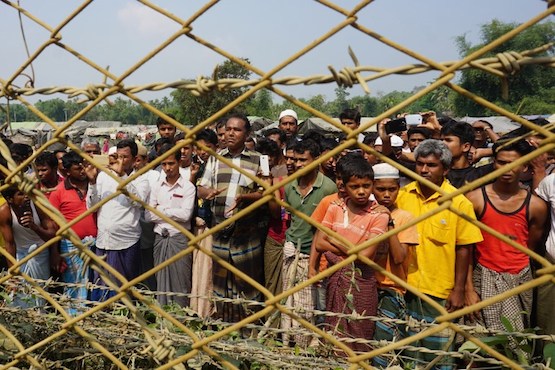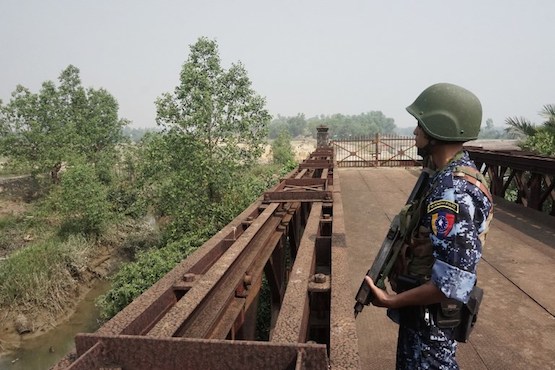Rohingya who remain in restive Rakhine face uncertain future
Those that stayed behind battle food shortages and pray for peace
 Minority Rohingya Muslims gather behind Myanmar's border lined with barbed wire fences in Maungdaw district, located in Rakhine State bounded by Bangladesh on March 18. (Photo by Joe Freeman/AFP)
Minority Rohingya Muslims gather behind Myanmar's border lined with barbed wire fences in Maungdaw district, located in Rakhine State bounded by Bangladesh on March 18. (Photo by Joe Freeman/AFP)March 23, 2018
Mohammad Salim and his family were packing their belongings and getting ready to flee when the violence erupted in the north of Rakhine State on Aug. 25, 2017 as Myanmar's military sought to target Rohingya Muslim militants.
However, unlike hundreds of thousands of Rohingya who have left the strife-torn state to live in camps in neighboring Bangladesh due to fear of ethnic persecution at the hands of the Myanmar army, Salim decided to stay put.
"We would have left if the situation deteriorated any further because we were living in a state of fear," says the 71-year-old from Myo Ma Ka Nyin Tan village near the town of Maungdaw.
Salim's village was not unscathed by the troubles, as the army razed homes and made what rights activists claim were arbitrary arrests to scare the Rohingya into leaving. But the village escaped the brunt of the campaign.
While a third of its residents opted to leave and make their way to Bangladesh 800 of the original population of 1,200 people, elected to stay and brave it out.
Salim's daughter, who is married and living in a separate village, decided to join the legions of refugees after seeing so many people's homes burned down by security forces and fearing her house could be next on the list.
Salim bases his livelihood on the crops he grows on four acres of paddy, bolstered by the income produced by his son's grocery shop.
But he says supplies often run low and fears of hunger and state-sanctioned violence prey on the villagers' minds despite Myanmar and Bangladesh inking a repatriation deal that Dhaka recently delayed.
As Salim's community faces food shortages, the government has dispatched aid there in the form of rice sacks on two occasions since August in collaboration with the International Red Cross.
"We fight for our daily survival and right now we have just about enough food to get by. But we can't tell what will happen in the future," the former schoolteacher told ucanews.com.
 A Myanmar border guard is posted at the Friendship Bridge across from Bangladesh in Maungdaw district of Rakhine State on March 18. (Photo by Joe Freeman/AFP)
A Myanmar border guard is posted at the Friendship Bridge across from Bangladesh in Maungdaw district of Rakhine State on March 18. (Photo by Joe Freeman/AFP)
No stranger to violence
He recalls similar episodes of violence that erupted in the state in the late 1970s and the 1990s, when masses of Rohingya also fled across the border.
But Salim described the current situation as setting a new precedent in terms of scale and terror.
"In my life, this is the worst situation I've ever seen," he says.
Over 671,000 Rohingya have left the state since the army's brutal crackdown began last summer following alleged attacks on police posts by the Arakan Rohingya Salvation Army (ARSA).
Hundreds are reported to still be fleeing the ravaged area on a weekly if not daily basis as reports emerge that the military is setting up security outposts on top of razed Rohingya villages.
Critics see this as a sign the refugees are not welcome to return. Myanmar refuses to recognize the term "Rohingya" or grant them citizenship status. It refers to the Muslim minority as Bangladeshi migrants.
Mohammad Furuk, a Rohingya Muslim from Pan Taw Pyi near Maungdaw, said he watched over 1,000 people scramble to leave the village in a panic but he decided to stay, a decision he doesn't regret.
"The situation is normalizing and the local authorities have urged us not to leave," the 60-year-old told ucanews.com.
The father of 10 owns a few acres of farmland but he says this is not enough to feed his family. Fortunately, the government has helped to provide rice sacks which have until now managed to bridge the gap.
"We are surviving, for now, but I can't say what will happen tomorrow," he adds.
Furuk refuted rumors that Rohingya Muslims were being forced to leave by Rohingya insurgent groups.
"The ARSA's name has come up a lot since last August, but to be honest we don't know who they really are," he said.
In a sign of recognition for the plight of Furuk's community, State Counselor Aung San Suu Kyi visited the village on Nov. 2.
There were an estimated 1.09 million Rohingya in Rakhine State who were not enumerated in the 2014 census, according to a government report on religion released in July 2016.
Diplomats estimate that not more than 100,000 Rohingya remain in the three major townships of Maungdaw, Buthidaung and Rathedaung in the northern part of the state. The Irrawaddy reported on Feb. 23 that only 79,000 Rohingya are still living in the state. It cited statistics provided by the local General Administration Department (GAD).
The GAD put the total Rohingya population before the latest crisis at 767,038, meaning the number has since dwindled by almost 90 percent.
The news report added that Rohingya accounted for 93 percent of the population in Maungdaw, 84 percent in Buthidaung and just 6 percent in Rathedaung as of last summer.
The center of Rakhine State has not been so badly affected by the violence. Here, over 120,000 Rohingya remain in camps for internally displaced persons (IDP). Another 150,000 have been scattered among villages in various townships such as Sittwe and Myauk-Oo.
However, unlike hundreds of thousands of Rohingya who have left the strife-torn state to live in camps in neighboring Bangladesh due to fear of ethnic persecution at the hands of the Myanmar army, Salim decided to stay put.
"We would have left if the situation deteriorated any further because we were living in a state of fear," says the 71-year-old from Myo Ma Ka Nyin Tan village near the town of Maungdaw.
Salim's village was not unscathed by the troubles, as the army razed homes and made what rights activists claim were arbitrary arrests to scare the Rohingya into leaving. But the village escaped the brunt of the campaign.
While a third of its residents opted to leave and make their way to Bangladesh 800 of the original population of 1,200 people, elected to stay and brave it out.
Salim's daughter, who is married and living in a separate village, decided to join the legions of refugees after seeing so many people's homes burned down by security forces and fearing her house could be next on the list.
Salim bases his livelihood on the crops he grows on four acres of paddy, bolstered by the income produced by his son's grocery shop.
But he says supplies often run low and fears of hunger and state-sanctioned violence prey on the villagers' minds despite Myanmar and Bangladesh inking a repatriation deal that Dhaka recently delayed.
As Salim's community faces food shortages, the government has dispatched aid there in the form of rice sacks on two occasions since August in collaboration with the International Red Cross.
"We fight for our daily survival and right now we have just about enough food to get by. But we can't tell what will happen in the future," the former schoolteacher told ucanews.com.
 A Myanmar border guard is posted at the Friendship Bridge across from Bangladesh in Maungdaw district of Rakhine State on March 18. (Photo by Joe Freeman/AFP)
A Myanmar border guard is posted at the Friendship Bridge across from Bangladesh in Maungdaw district of Rakhine State on March 18. (Photo by Joe Freeman/AFP)No stranger to violence
He recalls similar episodes of violence that erupted in the state in the late 1970s and the 1990s, when masses of Rohingya also fled across the border.
But Salim described the current situation as setting a new precedent in terms of scale and terror.
"In my life, this is the worst situation I've ever seen," he says.
Over 671,000 Rohingya have left the state since the army's brutal crackdown began last summer following alleged attacks on police posts by the Arakan Rohingya Salvation Army (ARSA).
Hundreds are reported to still be fleeing the ravaged area on a weekly if not daily basis as reports emerge that the military is setting up security outposts on top of razed Rohingya villages.
Critics see this as a sign the refugees are not welcome to return. Myanmar refuses to recognize the term "Rohingya" or grant them citizenship status. It refers to the Muslim minority as Bangladeshi migrants.
Mohammad Furuk, a Rohingya Muslim from Pan Taw Pyi near Maungdaw, said he watched over 1,000 people scramble to leave the village in a panic but he decided to stay, a decision he doesn't regret.
"The situation is normalizing and the local authorities have urged us not to leave," the 60-year-old told ucanews.com.
The father of 10 owns a few acres of farmland but he says this is not enough to feed his family. Fortunately, the government has helped to provide rice sacks which have until now managed to bridge the gap.
"We are surviving, for now, but I can't say what will happen tomorrow," he adds.
Furuk refuted rumors that Rohingya Muslims were being forced to leave by Rohingya insurgent groups.
"The ARSA's name has come up a lot since last August, but to be honest we don't know who they really are," he said.
In a sign of recognition for the plight of Furuk's community, State Counselor Aung San Suu Kyi visited the village on Nov. 2.
There were an estimated 1.09 million Rohingya in Rakhine State who were not enumerated in the 2014 census, according to a government report on religion released in July 2016.
Diplomats estimate that not more than 100,000 Rohingya remain in the three major townships of Maungdaw, Buthidaung and Rathedaung in the northern part of the state. The Irrawaddy reported on Feb. 23 that only 79,000 Rohingya are still living in the state. It cited statistics provided by the local General Administration Department (GAD).
The GAD put the total Rohingya population before the latest crisis at 767,038, meaning the number has since dwindled by almost 90 percent.
The news report added that Rohingya accounted for 93 percent of the population in Maungdaw, 84 percent in Buthidaung and just 6 percent in Rathedaung as of last summer.
The center of Rakhine State has not been so badly affected by the violence. Here, over 120,000 Rohingya remain in camps for internally displaced persons (IDP). Another 150,000 have been scattered among villages in various townships such as Sittwe and Myauk-Oo.
Comments
Post a Comment